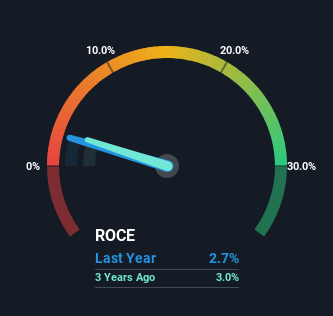- China
- /
- Metals and Mining
- /
- SHSE:600010
There Are Reasons To Feel Uneasy About Inner Mongolia Baotou Steel Union's (SHSE:600010) Returns On Capital

Finding a business that has the potential to grow substantially is not easy, but it is possible if we look at a few key financial metrics. Typically, we'll want to notice a trend of growing return on capital employed (ROCE) and alongside that, an expanding base of capital employed. If you see this, it typically means it's a company with a great business model and plenty of profitable reinvestment opportunities. In light of that, when we looked at Inner Mongolia Baotou Steel Union (SHSE:600010) and its ROCE trend, we weren't exactly thrilled.
Return On Capital Employed (ROCE): What Is It?
For those who don't know, ROCE is a measure of a company's yearly pre-tax profit (its return), relative to the capital employed in the business. Analysts use this formula to calculate it for Inner Mongolia Baotou Steel Union:
Return on Capital Employed = Earnings Before Interest and Tax (EBIT) ÷ (Total Assets - Current Liabilities)
0.027 = CN¥2.3b ÷ (CN¥154b - CN¥69b) (Based on the trailing twelve months to September 2023).
Therefore, Inner Mongolia Baotou Steel Union has an ROCE of 2.7%. Ultimately, that's a low return and it under-performs the Metals and Mining industry average of 6.5%.
Check out our latest analysis for Inner Mongolia Baotou Steel Union

Above you can see how the current ROCE for Inner Mongolia Baotou Steel Union compares to its prior returns on capital, but there's only so much you can tell from the past. If you'd like, you can check out the forecasts from the analysts covering Inner Mongolia Baotou Steel Union for free.
What Can We Tell From Inner Mongolia Baotou Steel Union's ROCE Trend?
On the surface, the trend of ROCE at Inner Mongolia Baotou Steel Union doesn't inspire confidence. Over the last five years, returns on capital have decreased to 2.7% from 10% five years ago. And considering revenue has dropped while employing more capital, we'd be cautious. This could mean that the business is losing its competitive advantage or market share, because while more money is being put into ventures, it's actually producing a lower return - "less bang for their buck" per se.
On a related note, Inner Mongolia Baotou Steel Union has decreased its current liabilities to 45% of total assets. So we could link some of this to the decrease in ROCE. Effectively this means their suppliers or short-term creditors are funding less of the business, which reduces some elements of risk. Some would claim this reduces the business' efficiency at generating ROCE since it is now funding more of the operations with its own money. Either way, they're still at a pretty high level, so we'd like to see them fall further if possible.
The Bottom Line On Inner Mongolia Baotou Steel Union's ROCE
We're a bit apprehensive about Inner Mongolia Baotou Steel Union because despite more capital being deployed in the business, returns on that capital and sales have both fallen. And, the stock has remained flat over the last five years, so investors don't seem too impressed either. With underlying trends that aren't great in these areas, we'd consider looking elsewhere.
Inner Mongolia Baotou Steel Union does have some risks, we noticed 2 warning signs (and 1 which is significant) we think you should know about.
While Inner Mongolia Baotou Steel Union isn't earning the highest return, check out this free list of companies that are earning high returns on equity with solid balance sheets.
New: AI Stock Screener & Alerts
Our new AI Stock Screener scans the market every day to uncover opportunities.
• Dividend Powerhouses (3%+ Yield)
• Undervalued Small Caps with Insider Buying
• High growth Tech and AI Companies
Or build your own from over 50 metrics.
Have feedback on this article? Concerned about the content? Get in touch with us directly. Alternatively, email editorial-team (at) simplywallst.com.
This article by Simply Wall St is general in nature. We provide commentary based on historical data and analyst forecasts only using an unbiased methodology and our articles are not intended to be financial advice. It does not constitute a recommendation to buy or sell any stock, and does not take account of your objectives, or your financial situation. We aim to bring you long-term focused analysis driven by fundamental data. Note that our analysis may not factor in the latest price-sensitive company announcements or qualitative material. Simply Wall St has no position in any stocks mentioned.
About SHSE:600010
Inner Mongolia Baotou Steel Union
Inner Mongolia Baotou Steel Union Co., Ltd.
Very low and overvalued.
Market Insights
Community Narratives




